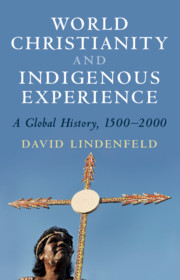Book contents
- World Christianity and Indigenous Experience
- World Christianity and Indigenous Experience
- Copyright page
- Contents
- Maps and Illustrations
- Tables
- Acknowledgments
- 1 Introduction
- 2 Colonial Latin America
- 3 Native North America
- 4 Sub-Saharan Africa and the Diaspora
- 5 The Middle East
- 6 India
- 7 East Asia
- 8 The Pacific
- Conclusion: Reflections on Concentrated and Diffuse Spirituality
- Endnotes
- General Bibliography
- Index
1 - Introduction
Published online by Cambridge University Press: 30 April 2021
- World Christianity and Indigenous Experience
- World Christianity and Indigenous Experience
- Copyright page
- Contents
- Maps and Illustrations
- Tables
- Acknowledgments
- 1 Introduction
- 2 Colonial Latin America
- 3 Native North America
- 4 Sub-Saharan Africa and the Diaspora
- 5 The Middle East
- 6 India
- 7 East Asia
- 8 The Pacific
- Conclusion: Reflections on Concentrated and Diffuse Spirituality
- Endnotes
- General Bibliography
- Index
Summary
The Spanish conquest of the Basin of Mexico largely succeeded in eradicating its indigenous religion. The Nahua responded by worshipping the Catholic saints, embracing the Day of the Dead, and turning to figures like the Virgin of Guadalupe, who appeared to a poor Indian peasant. The chapter also points to Nahua empowerment through education and a written vernacular that the missionaries provided. The Maya and Inca are also briefly considered.
Keywords
- Type
- Chapter
- Information
- World Christianity and Indigenous ExperienceA Global History, 1500–2000, pp. 1 - 30Publisher: Cambridge University PressPrint publication year: 2021

